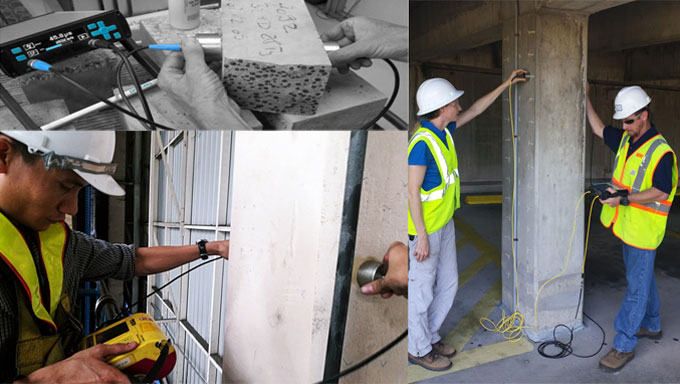
Details about Ultrasonic Pulse Velocity

This test is conducted for the purpose of evaluating the concrete quality with ultrasonic pulse velocity method with adherence to IS: 13311 (Part 1) ? 1992. The underlying principle of this test is ?
Under this method, testing is done by sending an ultrasonic pulse through the concrete and time of movement is calculated. Relatively, greater velocity exists if the quality of concrete is good with respect to density, consistency, homogeneity etc.
The following method is applied to ascertain the strength of hardened concrete with Ultrasonic Pulse Velocity :-
i) Making it ready for use: Prior to changing to the ?V? meter, the transducers should be attached to the sockets leveled as ?TRAN? and ? REC?.
The ?V? meter is activated with either: a) the internal battery, b) an external battery or c) the A.C line.
ii) Set reference: A reference bar is arranged to examine the instrument zero. The pulse time for the bar is inscribed on it. Prior to set it on the opposite ends of the bar, provide a coat of grease to the transducer faces. Fine-tune the ?SET REF? control unless the transit time of reference bar is captured on the instrument read-out.
iii) Range selection: For greater precision, it is suggested that the 0.1 microsecond range should be chosen for path length upto 400mm.
iv) Pulse velocity: After detecting the exact test points on the material to be tested, thorough measurement of the path length ?L? should be done. Provide couplant to the surfaces of the transducers and press it firmly onto the surface of the material.
It is suggested not to shift the transducers at the time of taking a reading since noise signals and errors in measurements may occur. Keep on retaining the transducers onto the surface of the material unless a reliable reading is shown on the display that is the time in microsecond for the ultrasonic pulse to pass through the distance ?L?. The mean value of the display readings should be captured while the units digit follows among two values.
Pulse velocity=(Path length/Travel time)
v) Partition of transducer leads: It is recommended to avoid the two transducer leads from getting in touch with each other at the time of taking the transit time measurements.
If it is not performed, the receiver lead will pick-up unnecessary signals from the transmitter lead and it leads to an wrong display of the transit time.
Interpretation of Results
The quality of concrete with regard to consistency, occurrence or nonexistence of internal faults, cracks and segregation, etc, indication of the level of workmanship provided, can thus be examined with the following guidelines which are changed for defining the quality of concrete in structures with regard to the ultrasonic pulse velocity.


